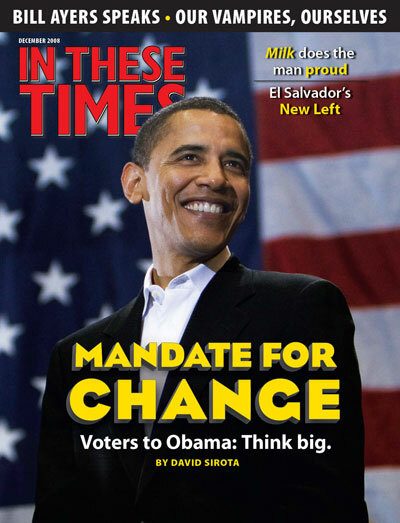Inside the Shadow Factory
James Bamford’s important new book details America’s post-9/11 surveillance-industrial complex
Brian Beutler

Most Americans probably do not know what the NSA is. Among those who do, a great percentage likely have only a vague sense of what the National Security Agency actually does, with little knowledge of its domestic activities and history of lawbreaking. Anyone who falls into either of these two categories should begin by reading journalist James Bamford’s 1983 book, The Puzzle Palace.
But those paying closer attention to the agency will know that before the Sept. 11 terrorist attacks, the NSA, with support from the Bush White House, had been fighting its own obsolescence. The agency was figuring out ways to access communications that travel via fiber-optic cables along the ocean floor – now a common infrastructure for communications systems. They will know that after Sept. 11, the NSA, along with major telecommunications companies like AT&T and Verizon, participated in a secret program to wiretap American citizens and mine domestic communication data for clues in the war on terror – in contravention of U.S. law.
They will know that once American journalists exposed this program, the Bush administration campaigned to legalize many of its crimes and – with the help of Congress – immunize from prosecution the very people who abetted those crimes.
And they might also know that only three months after the administration won that campaign, ABC News reported that NSA analysts had knowingly eavesdropped on the personal conversations of hundreds of American citizens and soldiers.
People who already know much of this can forgo The Puzzle Palace and move straight to Bamford’s new book, The Shadow Factory: The Ultra-Secret NSA from 9/11 to the Eavesdropping on America (Doubleday, October).
It is against this backdrop that Bamford recounts how the NSA transformed itself from an agency beset by budgetary problems, a Cold War mindset and bureaucratic snafus, into an espionage behemoth – and how it quickly became too large to effectively police communications’ networks, and too power-hungry to follow the law.
In January 2000, two Saudi men – Yemeni-born Khalid al-Mihdhar and his boyhood friend Nawaf al-Hazmi – flew from Kuala Lumpur, Malaysia, to Los Angeles to begin an operation that would culminate in the destruction of the World Trade Center and one of the five sides of the Pentagon. The duo had begun their journey from the Middle East only a few weeks prior, after they received orders from al Qaeda to travel east. The NSA intercepted that call.
In a functioning intelligence community, this information might have passed smoothly from the techno-spooks who first discovered it, to the State Department bureaucrats who could have prevented the men from entering the country. Or, perhaps, to the FBI anti-terror agents who might have intercepted them upon their arrival.
But territorial rivalries and antiquated protocols got in the way. The NSA sat on the information for months, and by the time anyone understood the significance of what had been recorded, it was too late.
At the time of the attacks, Air Force Gen. Michael Hayden headed the NSA. In Bamford’s telling, Hayden had spent his two-and-a-half year tenure assiduously avoiding the sorts of legally questionable – or downright illegal – activities that had brought the agency to its knees in the aftermath of the Nixon era.
After the 2001 attacks, things changed. Armed with a ballooning budget, Hayden did an about-face, shifting the agency’s focus to wired communications and inserting its tendrils all over the world, even, famously, where they didn’t belong.
“Had this [warrantless wiretapping program] been in place prior to the attacks,” Hayden told the Senate Intelligence Committee after the illegal operation had been revealed, “the two hijackers [al-Mihdhar and al-Hazmi] almost certainly would have been identified as who they were, what they were, and most importantly, where they were.”
That was the post hoc justification. But it was a weak one. As Bamford writes, “If Hayden had simply done as his job allowed and traced the calls and e-mail back from the Yemen ops center and obtained a FISA warrant for the California phone numbers and e-mail address, he would have discovered who, what and where they were back in the spring of 2000.”
The warrantless wiretapping program may have been the single biggest affront to the Constitution in the post-Sept. 11 era. But as Bamford notes in detail, it was in some senses less dangerous for what it was, and more dangerous for what it represented: a surveillance state run amok.
In the weeks and months after the attack, the intelligence community found itself in control of a huge amount of money, contracting with domestic and foreign companies to build and proliferate tools needed to spy on the world – creating, in effect, a surveillance-industrial complex.
In such a milieu, it’s hardly surprising that the government bugged the conversations of officials from countries that serve on the U.N. Security Council in the run up to the Iraq War – the idea being, in the words of an agency official, that the “gamut of information … could give U.S. policymakers an edge in obtaining results favorable to U.S. goals or to head off surprises.”
It’s similarly unsurprising that the NSA has disseminated its technology to some of the worst human rights violators in the world. As part of these arrangements, Bamford notes, “the U.S. [gets] full access to the data,” and gives the partner country serious tools of oppression.
As a Justice Department attorney told the House Judiciary Committee after the wiretapping program was revealed, “I think the president has made it clear that there is no other program that involves domestic electronic surveillance of domestic communications,” leaving open the possibility that foreign electronic surveillance of both foreign and domestic communications is still ongoing.
The Shadow Factory isn’t perfect. Bamford has a tendency to describe, in omniscient detail, events – a meeting at an al Qaeda safe house, or an afternoon meeting at the NSA – that he couldn’t possibly have witnessed. And he at times seems credulous about Hayden’s legal diligence before Sept. 11, suggesting a man transformed by the shock of the attacks into a soldier with an unfortunate but understandable willingness to flout the law.
While this interpretation is possible, it doesn’t explain why, as Bamford writes, “Despite the law … Hayden decided to ignore the court and secretly begin seeking the cooperation of the country’s telecoms … even before 9/11.”
Still, The Shadow Factory is a triumphant mix of research and reportage, and it deserves to be read widely. It is a wake-up call to anybody who thinks the threats posed by the surveillance state will disappear with George W. Bush.





